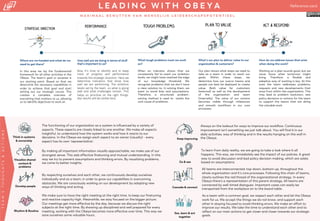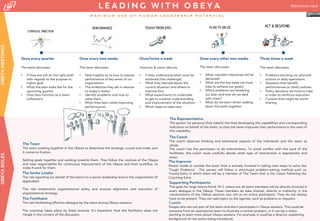Leading With Obeya - Reference Card EN.pdf
- 1. M A X I M U M O F H U M A N L E A D E R S H I P P O T E N T I A L U S E L E A D I N G W I T H O B E Y A Reference card
- 2. WAT AAN DE MUUR HANGT All teams are interconnected; top-down, bottom-up, throughout the whole organization and it's core processes. Following this chain of teams, clearly outlines the red thread of the organizational strategy. In every Obeya there's a representation of this parent strategy. All teams are connected by well-timed dialogues. Important cases can easily be transported from the workplace on to the board table. By respecting ourselves and each other, we continuously develop ourselves individually and as a team, in order to grow our capabilities in overcoming obstacles. We are consciously working on our development by adapting new ways of thinking and acting. T E A M ' S T H O U G H T S & A C T I O N S We make sure to have the right meeting at the right time, to keep our finetuning and reactive capacity high. Meanwhile, we stay focused on the bigger picture. Our meetings get more effective by the day, because we discuss the right subjects at the right time. By showing up disciplined and well prepared for every meeting, working with the Obeya becomes more effective over time. This way we save ourselves some valuable hours. Always on the lookout for ways to improve our workflow. Continuous improvement isn't something we just talk about. You will find it in our daily activities, way of thinking and in the results hanging on the wall in the Obeya. By making all important information visually approachable, we make use of our strongest sense. This aids effective finetuning and mutual understanding. In this way we try to prevent assumptions and thinking errors. By visualizing problems, we come to better insights. To learn from daily reality, we are going to take a look where it all happens. This way, we immediately see the impact of our policies. A great way to avoid discussion and bad policy decision-making, which are solely based on assumptions. The functioning of our organization as a system is influenced by a variety of aspects. These aspects are closely linked to one another. We make all aspects insightful, to understand how the system works and how it reacts to our decisions. In the Obeya we assign each aspect to an owner (visually) - every aspect has its own ŌĆśrepresentative'. As a team with a common goal, we respect each other and let the Obeya work for us. We accept the things we do not know, and support each other in staying focused to avoid thinking errors. We make an effort to improve our results. We take the time to understand each other and to reflect on our main actions to get closer and closer towards our strategic goals. Where are we headed and what do we need to get there? In this area we lay the fundamental framework for all other activities in the Obeya. The teamŌĆÖs goal or purpose is our starting point. Based on that we determine the necessary capabilities in order to achieve that goal and start setting out our strategic course. This creates a complete overview of everything that matters to us, allowing us to identify objectives to work on. How well are we doing in terms of stuff thatŌĆÖs important to us? Now itŌĆÖs time to identify and to keep track of progress and performance towards the strategic direction. Here we determine indicators that show how well we are performing. The ambition levels set by the team us what is going well and what challenges remain. This helps us prioritize on the right things. Key results will be visible here. WhatŌĆÖs our plan to deliver value to our organization & customers? Our plan shows what steps we need to take as a team in order to reach our goals. Within these steps, we determine how our scarce means and people can best be deployed to create value. Both value for customers (external) as well as the development of the organization and team (internally). The value of our actions becomes visible through milestones and smooth workflows in our core processes. What tough problems must we work on? When an indicator shows that we consistently fail to reach our ambition levels, we might have reached the edge of our knowledge threshold. We recognize problems that we donŌĆÖt have a clear solution to. In solving them, we want to avoid bias and assumptions. Therefore, a structured problem- solving method is used to tackle the root cause of problems. How do we address issues that arise when doing the work? Working on a plan sounds good, but we never know what tomorrow might bring. Therefore, a flexible and adaptive way of working is key. At this area the team addresses problems, requests and new developments that arise from within the organization. This may lead to problem resolution, new policy decisions or actions for the team to support the teams that are doing the valuable work. M A X I M A A L B E N U T T E N V A N M E N S E L I J K L E I D E R S C H A P S P O T E N T I E E L L E A D I N G W I T H O B E Y A Reference card Think in systems & ownership Visualize shared context & problems Develop people Rhythm & Routine Keep improving Go & see Cascade & connect See, learn & act together
- 3. OBEYA MEETINGS Once every quarter The team discusses: ŌĆó If they are still on the right path with regards to the purpose or higher goal ŌĆó What the plan looks like for the upcoming quarter ŌĆó How they function as a team (reflection) Once every two weeks The team discusses: ŌĆó New insights as to how to expose performance of key areas of our organization ŌĆó The ambitions they set in relation to todayŌĆÖs reality ŌĆó Identify problems and how to solve them. ŌĆó What they learn while improving performances. The Facilitator The role facilitating effective dialogue by the team during Obeya sessions. The coaching takes place by fixed routines. It's important that the facilitator does not mingle in the content of the discussion. OBEYA ROLES The Representative The person (or persons) that take(s) the lead developing the capabilities and corresponding indicators on behalf of the team, so that the team improves their performance in the area of this capability. The Coach The coach observes thinking and behavioral aspects of the individuals and the team as whole. The coach has the permission to do interventions. To avoid conflict with the work of the facilitator, the coach must carefully decide what type of intervention is appropriate and when. The Senior Leader The role reporting (on behalf of the team) to a senior leadership level in the organization (if applicable). This role implements organizational policy and ensures alignment and execution of organizational strategy. Supporting Participants This goes for large teams (think 10+), where not all team members will be directly involved in every dialogue in the Obeya. These members do take interest, directly or indirectly, in the conversations of the Obeya sessions, but not as an active participant. They do not always have to be present. They can add topics to the agenda, such as problems or requests. The Team The team working together in the Obeya to determine the strategic course and make sure it comes to fruition. Setting goals together and working towards them. They follow the routines of the Obeya and take responsibility for continuous improvement of the Obeya and their workflow, to make it work for them. Guests People who are not part of the team and don't participate in Obeya sessions. This could be someone from an operational team to illustrate a certain problem, or it can be a visitor wanting to learn more about Obeya sessions. For example, it could be a director, explaining background of new policy being introduced. Once/twice a week Improver & coach discuss: ŌĆó If they understand what must be achieved (the challenge). ŌĆó What they learned about the current situation and where to improve first ŌĆó What experiments to undertake to get to a better understanding and improvement of the situation ŌĆó Which steps to take next Once every other two weeks The team discusses: ŌĆó What valuable milestones will be delivered? ŌĆó What are the key steps we must take to achieve our goals? ŌĆó Which problems are hindering our plan and how do we deal with them? ŌĆó What do we learn whilst walking down this path together. Three times a week The team discusses: ŌĆó Problems blocking our planned actions or daily operations. ŌĆó Requests that benefit performances or clarify policies. ŌĆó Policy decisions we have to take in order to reinforce execution. ŌĆó Context that might be worth sharing. The Improver Person inside or outside the team that is actively involved in taking next steps to solve the ŌĆśTough ProblemsŌĆÖ. The person will follow a structured problem-solving method such as Toyota Kata, in which there will be a member of The Team that is the Coach following the Coaching Kata. L E A D I N G W I T H O B E Y A Reference card M A X I M U M U S E O F H U M A N L E A D E R S H I P P O T E N T I A L
- 4. L E A D I N G W I T H O B E Y A Example Obeya: The Bike Factory M A X I M U M U S E O F H U M A N L E A D E R S H I P P O T E N T I A L Templates, materials, events, videoŌĆÖs and more at www.leadingwithobeya.com



